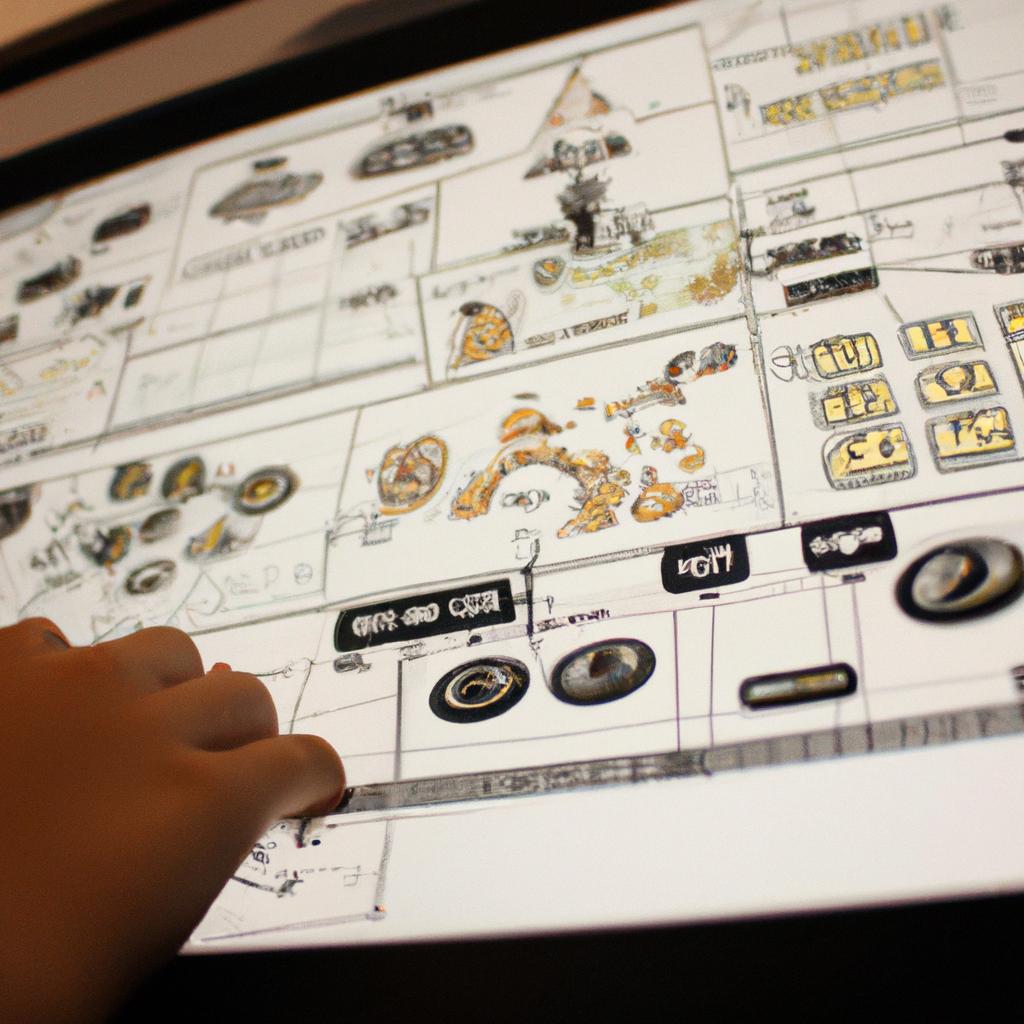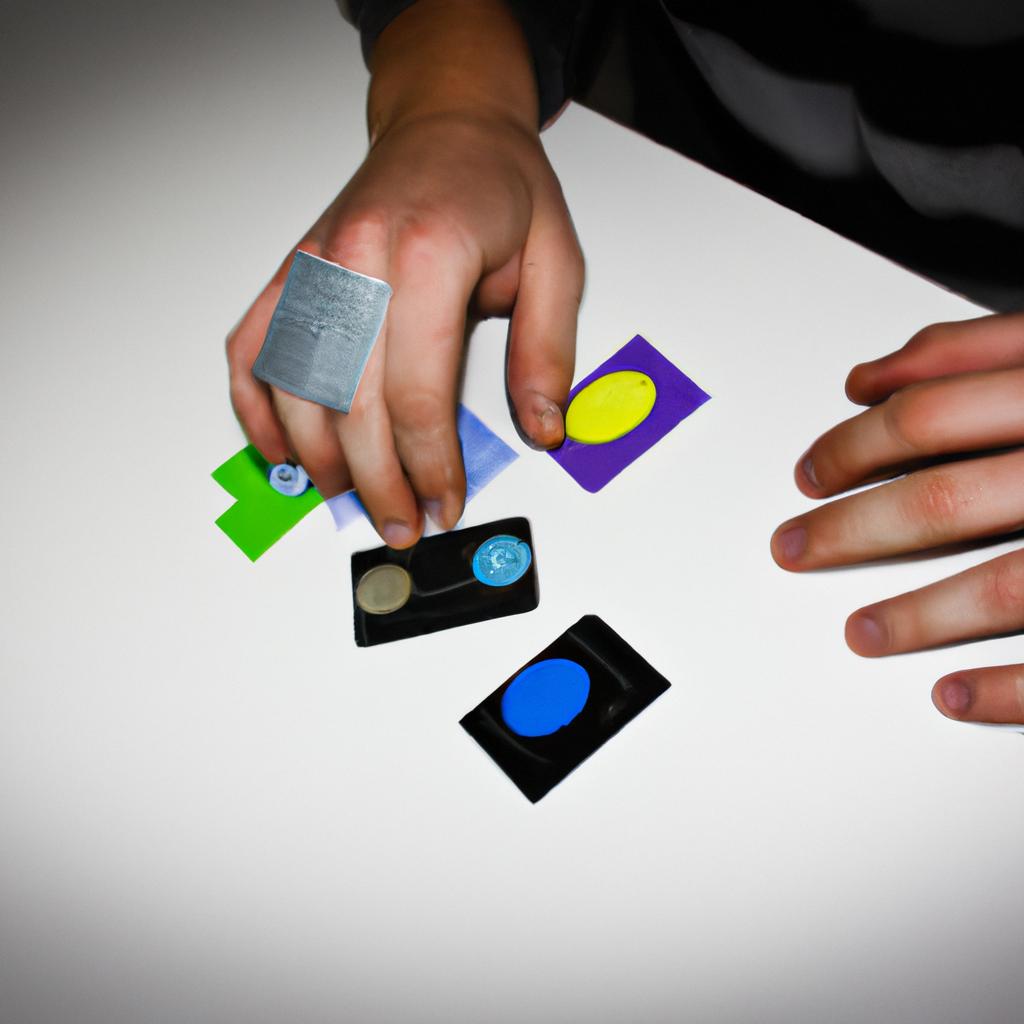User Experience in Games: The Impact on Game Design

The user experience (UX) in games has become an essential aspect of game design, shaping the way players interact with and perceive virtual worlds. The impact of UX on game design is evident through its influence on player engagement, satisfaction, and overall enjoyment. For instance, consider a hypothetical scenario where a player enters a fantasy role-playing game and encounters clunky controls, confusing menus, and inconsistent feedback mechanisms. These issues hinder the player’s immersion in the game world and disrupt their ability to fully engage with the gameplay mechanics. In order to create successful gaming experiences that captivate players from start to finish, designers must carefully consider how elements such as interface design, controls responsiveness, visual aesthetics, audio cues, storytelling techniques, and level progression contribute to the overall user experience.
Understanding the relationship between user experience and game design requires examining key concepts within both fields. User experience encompasses various aspects of human-computer interaction (HCI), including perception, cognition, emotions, motivations, and behavior. It focuses on designing intuitive interfaces that facilitate smooth navigation and efficient interactions with digital environments. Game design involves crafting interactive experiences that provide challenges or rewards for players’ actions while maintaining coherence within the narrative structure. By combining these two disciplines effectively, developers can create games that not only entertain but also deeply engage and resonate with players.
To achieve a compelling user experience in games, designers must prioritize player-centered design. This involves conducting research to understand the target audience’s preferences, motivations, and expectations. By gathering insights through surveys, interviews, or playtesting sessions, designers can identify pain points and areas for improvement in the gameplay experience.
One crucial aspect of user experience in game design is interface design. A well-designed interface should be intuitive, visually appealing, and provide clear guidance to players. Elements like menus, HUDs (heads-up displays), tooltips, and navigation systems should be seamlessly integrated into the game’s aesthetics while remaining easy to understand and use.
Controls responsiveness is another essential factor that contributes to overall user experience. Players expect precise control over their characters or avatars, so a delay or unresponsive input can significantly impact immersion and enjoyment. Designers must ensure that controls are fluid and responsive across different platforms and devices.
Visual aesthetics play a vital role in creating an immersive gaming experience. The art style, graphics quality, lighting effects, and animations all contribute to the atmosphere and mood of the game world. Consistency in visual design helps establish a coherent narrative and enhances players’ emotional connection to the game.
Audio cues also play a significant role in enhancing user experience. Sound effects, background music, voice acting, and ambient sounds help create an immersive environment by providing auditory feedback that aligns with the gameplay events. Well-designed audio can evoke emotions, enhance tension or excitement level, guide players’ attention or communicate important information.
Storytelling techniques are crucial for engaging players throughout their gaming journey. A compelling narrative with well-developed characters can keep players invested in the game world. Interactive storytelling elements such as branching narratives or player choices further empower players to shape their own experiences within the game.
Lastly, level progression should be carefully designed to maintain player engagement. Balancing difficulty curves ensures that players are consistently challenged without feeling frustrated or bored. Providing meaningful rewards and achievements can motivate players to continue playing and exploring the game’s content.
In conclusion, user experience in games is a critical consideration for game designers. By focusing on intuitive interfaces, responsive controls, captivating visuals, immersive audio, engaging storytelling, and thoughtful level progression, developers can create games that deliver enjoyable experiences and keep players coming back for more.
Importance of User Experience in Games
Importance of User Experience in Games
User experience (UX) plays a crucial role in the design and development of games as it directly influences players’ enjoyment, satisfaction, and overall perception of the game. With the increasing complexity and competitiveness of the gaming industry, developers are recognizing that creating an immersive and engaging user experience is essential for success.
To illustrate this significance, let us consider a hypothetical scenario where two similar games with identical gameplay mechanics are released simultaneously. However, Game A focuses on providing a seamless and intuitive user experience while Game B neglects UX considerations. Despite having similar core features, Game A would likely attract more players due to its superior UX, ultimately leading to higher player retention rates and increased revenue.
Several factors contribute to the importance of user experience in games:
- Player Engagement: An optimal user experience captivates players from the very beginning, drawing them into the game’s world and keeping them engaged throughout their playtime. This results in extended session durations and increased player loyalty.
- Enjoyment: By prioritizing elements such as smooth controls, responsive feedback systems, visually pleasing graphics, and immersive sound design, game designers can enhance players’ enjoyment levels significantly.
- Satisfaction: Players seek gratification when playing games; they want to feel challenged but not overwhelmed or frustrated. Striking the right balance between difficulty levels, rewarding achievements, and meaningful progression systems leads to greater player satisfaction.
- Positive Word-of-Mouth: Providing a remarkable user experience generates positive word-of-mouth recommendations among players. This organic promotion can considerably impact a game’s popularity and sales.
Table: Factors Impacted by User Experience
| Factors | Positive Impact |
|---|---|
| Player engagement | Extended session duration |
| Enjoyment | Heightened entertainment value |
| Satisfaction | Enhanced sense of accomplishment |
| Positive word-of-mouth | Organic promotion and increased player acquisition |
In conclusion, the importance of user experience in games cannot be overstated. By prioritizing UX considerations, game developers can create an immersive and enjoyable gaming environment that attracts players, enhances their engagement, satisfaction, and overall experience. In the subsequent section, we will explore the various elements that contribute to creating a comprehensive user experience in games.
Transition: Moving forward into exploring the Elements of User Experience in Games…
Elements of User Experience in Games
Section Title: The Role of User Experience in Shaping Game Design
To understand the impact of user experience (UX) on game design, it is crucial to delve into specific elements that contribute to a captivating gaming experience. This section explores how UX considerations shape game design decisions by focusing on key aspects such as player engagement, intuitive interfaces, and immersive storytelling. Through analysis and examination of these factors, we can gain insights into the critical role played by UX in shaping the overall quality of games.
The Importance of Player Engagement:
Player engagement lies at the core of successful game design, ensuring that players remain invested and immersed throughout their gameplay experience. For example, consider a hypothetical scenario where a strategy-based mobile game lacks engaging mechanics or challenges. Players may quickly lose interest due to a lack of stimulation or novelty within the game’s mechanics, leading to disengagement and eventual abandonment.
Elements Contributing to Intuitive Interfaces:
In addition to player engagement, creating intuitive interfaces is another vital aspect influenced by UX considerations. Games with complex controls or cluttered menus often frustrate players and hinder their ability to fully enjoy the gaming experience. By implementing well-designed interfaces that are easy to navigate and understand, developers can enhance accessibility for both casual gamers and more experienced players alike.
Immersion through Storytelling:
An essential element in many popular video games is an engrossing narrative that allows players to become emotionally invested in the story being told. An interactive storyline combined with compelling characters creates a sense of immersion that captivates players’ attention. As they progress through the game world, users develop a personal connection with its inhabitants and events – driving them forward towards completion.
Emotional Impact:
Below is an example bullet-point list showcasing various emotional responses evoked by effective UX design:
- Awe-inspiring visuals transport players into richly detailed virtual worlds.
- Challenging gameplay generates excitement and feelings of accomplishment upon overcoming obstacles.
- Narrative twists and character development provoke empathy, creating emotional connections.
- Seamless multiplayer experiences foster camaraderie and competition among players.
Table: Emotional Responses in Gaming
| Emotion | Example |
|---|---|
| Excitement | Thrilling chase scenes or epic boss battles. |
| Tension | Heart-pounding encounters with limited resources. |
| Satisfaction | Unlocking achievements or completing challenging quests. |
| Empathy | Feeling compassion towards characters through their struggles. |
The Role of User Testing in Game Development:
By considering these elements of user experience within game design, developers can create more immersive and enjoyable gaming experiences for players. However, to ensure the effectiveness of UX decisions, it is essential to incorporate user testing throughout the game development process. This will enable designers to gather feedback from real users, identify potential usability issues, and make informed improvements that align with player expectations.
Understanding how user experience influences game design leads us to explore the vital role played by user testing in ensuring optimal gameplay experiences for all players.
Role of User Testing in Game Development
Transition from Previous Section H2:
Building upon the understanding of the various elements that contribute to user experience in games, it is crucial to recognize the role of user testing in game development. By evaluating and analyzing how players interact with a game, developers can gain valuable insights into enhancing the overall user experience. This section will delve into the significance of user testing and its impact on shaping game design.
The Importance of User Testing
To emphasize the importance of user testing, let us consider a hypothetical case study involving an action-adventure video game. In this scenario, the developers have created an intricate combat system that they believe offers an engaging and immersive gameplay experience. However, during initial playtesting sessions, it becomes evident that many players struggle to grasp and effectively utilize the mechanics of this combat system. By conducting further user tests, developers can identify specific pain points and areas where improvements are needed.
In order to ensure optimal user experiences in games, there are several key reasons why incorporating user testing is crucial:
- Identifying usability issues: Through iterative rounds of testing, potential usability hurdles can be identified early on, allowing for necessary adjustments before release.
- Optimizing player engagement: Gathering feedback from users provides invaluable insight into what aspects of a game successfully engage them or fall short.
- Enhancing accessibility: User testing helps pinpoint any barriers preventing certain individuals from fully enjoying a game’s features, ultimately leading to more inclusive designs.
- Refining game mechanics: Observing how players navigate through different levels or puzzles allows designers to refine these components for better flow and challenging yet enjoyable experiences.
| Reasons for Incorporating User Testing |
|---|
| Identifying usability issues |
| Optimizing player engagement |
| Enhancing accessibility |
| Refining game mechanics |
Table 1: Key reasons for incorporating user testing
Balancing User Experience and Game Mechanics
By actively including users in the development process, game designers are better equipped to strike a balance between user experience and game mechanics. While it is essential to create compelling gameplay systems that align with the intended vision, understanding how players interact with these mechanics is equally significant. The insights gained from user testing enable developers to refine and fine-tune not only the overall user experience but also ensure that game mechanics complement and enhance one another seamlessly.
With a solid understanding of the importance of user testing in shaping game design, we can now explore further into the intricate relationship between balancing user experience and game mechanics.
Transition:
Moving forward, let us examine how the harmony between user experience and game mechanics forms an integral part of successful game design without compromising on player engagement.
Balancing User Experience and Game Mechanics
Building upon the insights gained from user testing, game designers are able to refine their creations by finding a delicate balance between user experience and game mechanics. This symbiotic relationship plays a crucial role in shaping the overall design of games, as it directly influences how players engage with and perceive the gameplay.
User feedback serves as an invaluable resource for developers seeking to enhance the user experience (UX) of their games. By understanding player preferences and expectations, designers can fine-tune various aspects such as controls, visuals, audio, and pacing. For instance, consider a hypothetical scenario where a team is developing an action-adventure game set in a dystopian world. Through extensive user testing sessions, they discover that players find the combat system too complex and overwhelming. Armed with this insight, the team iterates on the mechanics to introduce more intuitive controls and streamlined actions, resulting in a more enjoyable and accessible gaming experience.
To ensure effective incorporation of UX principles into game design, developers often adhere to key guidelines:
- Provide clear objectives and goals: Games should communicate their core objectives clearly so that players understand what needs to be accomplished.
- Foster meaningful interactions: Encouraging interactive elements within gameplay fosters engagement and emotional investment.
- Maintain consistent visual aesthetics: Consistency in visual style helps create an immersive environment that aligns with players’ expectations.
- Balance challenge and reward: Striking the right balance between difficulty levels and corresponding rewards ensures sustained motivation while avoiding frustration or boredom.
| Key Guidelines for User Experience in Game Design |
|---|
| Provide Clear Objectives |
| Clearly articulate game goals |
| Guide players through objective markers/waypoints |
| Present information intuitively via HUD |
| Offer in-game hints or tutorials as needed |
In conclusion, user testing plays a crucial role in shaping the design of games by providing valuable insights into player preferences. Game designers can then use this feedback to strike a balance between user experience and game mechanics, resulting in more enjoyable and engaging gameplay. By adhering to key guidelines, developers can create immersive experiences that captivate players while meeting their expectations.
Adapting User Experience to Different Platforms
Building upon the delicate balance between user experience and game mechanics, it is crucial for game designers to adapt their approach to different platforms. By tailoring the user experience to specific platforms, developers can ensure that players have an optimal gaming experience regardless of the device they choose to play on.
To illustrate the importance of adapting user experience to different platforms, let us consider a hypothetical scenario where a popular puzzle game called “Mind Bender” is being developed for both console gaming and mobile devices. The developers realize that while the core gameplay mechanics remain the same across platforms, certain aspects need to be adjusted in order to enhance user experience. Here are some key considerations:
-
Screen Size and Input Method:
- Console Gaming: With larger screens and dedicated controllers, players may expect more intricate visuals and complex control schemes.
- Mobile Devices: Given limited screen real estate and touch-based input, simplicity in design becomes essential for ease of use.
-
Play Sessions:
- Console Gaming: Players often engage in longer play sessions; therefore, incorporating immersive storytelling elements can help maintain interest over extended periods.
- Mobile Devices: Quick pick-up-and-play sessions cater better to on-the-go gaming habits, making short levels or bite-sized challenges more suitable.
-
Social Integration:
- Console Gaming: Multiplayer modes with online leaderboards or cooperative gameplay features encourage social interaction among console gamers.
- Mobile Devices: Integrating social media sharing options or multiplayer functionality through local Wi-Fi connections appeals to the mobile gamer’s desire for connectivity.
-
Performance Optimization:
- Console Gaming: Developers can prioritize high-quality graphics and advanced visual effects due to powerful hardware capabilities.
- Mobile Devices: Optimizing performance by reducing resource requirements allows games to run smoothly on a variety of mobile devices with varying specifications.
Table showcasing Adaptation Considerations for Different Platforms:
| Platform | Screen Size & Input | Play Sessions | Social Integration | Performance Optimization |
|---|---|---|---|---|
| Console Gaming | Larger screens, | Longer play | Online leaderboards, | High-quality graphics, |
| dedicated controllers. | sessions | cooperative gameplay. | advanced visual effects. | |
| Mobile Devices | Limited screen real | Quick pick-up-and- | Social media sharing, | Optimized performance by |
| estate, touch-based | play sessions | local multiplayer via Wi-Fi connectivity reducing resource requirements |
In conclusion, the adaptation of user experience to different platforms is crucial for game designers seeking to provide an optimal gaming experience. By considering factors such as screen size and input method, play sessions, social integration, and performance optimization, developers can tailor their games to suit the unique characteristics of each platform. This flexibility ensures that players across various devices can enjoy a seamless and engaging gameplay experience.
Looking ahead to the future of user experience in game design…
The Future of User Experience in Game Design
When it comes to designing games, adapting the user experience (UX) to different platforms is crucial. Each platform has its unique characteristics and limitations that impact how players interact with the game. For instance, let’s consider a popular multiplayer online battle arena (MOBA) game like League of Legends. The UX design needs to be tailored differently for PC players versus mobile users.
To illustrate this point, imagine a hypothetical scenario where the MOBA game mentioned earlier decides to release a mobile version. In order to adapt the UX effectively, several considerations must be taken into account:
- Screen Size: Mobile devices generally have smaller screens compared to PCs or gaming consoles. This necessitates optimizing UI elements such as buttons, icons, and text size so they are easily readable and accessible on smaller displays.
- Controls: Unlike PCs or consoles that offer physical controllers or keyboards, mobile gaming relies heavily on touch interactions. Designing intuitive touch controls becomes essential in ensuring smooth gameplay experiences without sacrificing complexity.
- Performance: Mobile devices may not possess the same processing power as high-end gaming rigs. Game developers need to optimize graphics quality, frame rates, and overall performance to ensure enjoyable gameplay even on less powerful hardware.
- Connectivity: While PCs and consoles typically provide stable internet connections through Ethernet cables or Wi-Fi networks, mobile gamers often rely on cellular data or unstable Wi-Fi signals. It becomes critical to create seamless experiences by minimizing latency issues and providing alternative offline modes.
Adapting UX design across various platforms requires careful consideration of these factors while maintaining consistent core gameplay mechanics and features. By addressing these challenges head-on, game designers can maximize player engagement regardless of the platform they choose.
| Platform | Screen Size | Controls | Performance |
|---|---|---|---|
| PC | Larger | Keyboard/Mouse | High |
| Console | TV-sized | Gamepad | High |
| Mobile | Smaller | Touchscreen | Varied/Modest |
In conclusion, adapting the user experience to different platforms is a critical aspect of game design. The unique characteristics and limitations of each platform necessitate careful consideration in order to provide an optimal gaming experience for players. By addressing factors such as screen size, controls, performance, and connectivity, developers can create engaging games that appeal to diverse audiences across various platforms.









